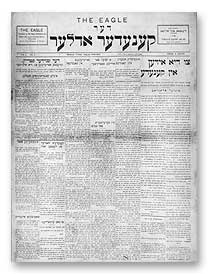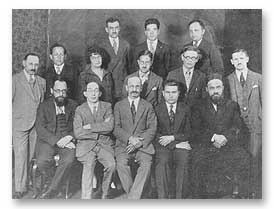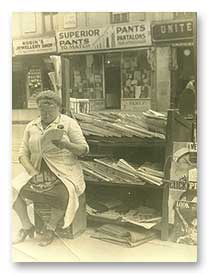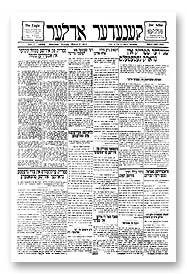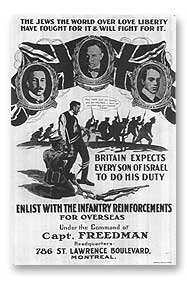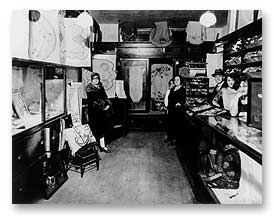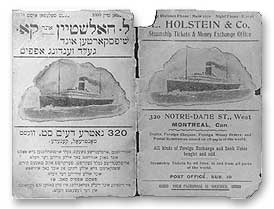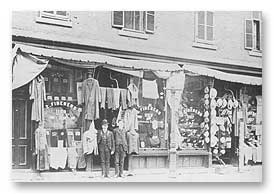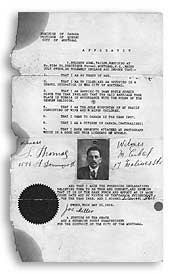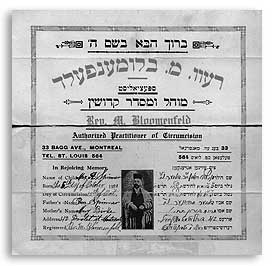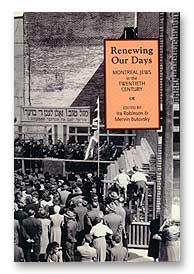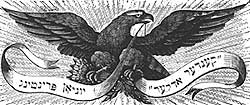
| The Eagle | Strike of Yiddish School Children | A Journalist Looks Back (boarders & weddings) |
| The Doctor's Strike against the Jews | Montreal Jews in 20th century |
THE YIDDISH PRESS (c. 1907)
The launching of the Keneder Odler was thus an immediate success, so great was the desire in the Jewish district to keep abreast of the latest developments in the city, in their own community and beyond. A whole generation of newly-arrived Yiddish-speaking immigrants who knew nothing of their new milieu learned the rudiments of Montreal and Canadian political life from the pages of this daily newspaper. Thanks to the Keneder Odler, Jewish philanthropic societies, landsmanshaftn, synagogues, recently established trade unions, and numerous small educational and cultural associations could finally reach their public. As well, newcomers affected by their expatriation and nostalgia for their country of origin could finally recognize in the pages of the Yiddish newspaper a certain familiar way of being and of reacting, as well as a language which reminded them of their shtetl, or now-remote native region. Thanks to his newspaper, amply demonstrated in his memoirs published in 1946 under the title Mayn Lebns Rayze, Wolofsky became one of the most respected and significant leaders of Jewish Montreal. It should be understood that Wolofsky had founded his newspaper in the hope of contributing significantly to the development of its community, and to bring together energies dispersed by the worries of immigration and adaptation to a new environment. From the start, in the first issue published on August 30, 1907, the owner of the Keneder Odler delivered the message
The offices of the Keneder Odler in these first years was not a place where one thought calmly about the problems arising from the integration of a recently-arrived community. Quite the contrary, the exuberant instability caused by massive arrivals of immigrants and the population density of the Jewish district then located close to the port, contributed to an atmosphere of mob rule at any hour of the day in the editorial office of the newspaper. Many newcomers, who had left Eastern Europe without material resources and with nobody to truly rely on in Montreal, went almost immediately to express their grievances in the offices of the Keneder Odler. Under these conditions owner Hirsch Wolofsky, chief editor Reuben Brainin, and the employees of the newspaper, unceasingly answered the questions and the requests of a multitude of individuals for whom the Keneder Odler was the only point of reliable reference in Montreal. For decades the Yiddish daily acted as a signal post
-Pierre Anctil Strike of Yiddish School Children in Aberdeen School Reuben Brainin Keneder Odler, March 2, 1913 A strike of school children in Montreal is the latest sensation. This time it is Jewish pupils on strike after a teacher insulted the pride of the Jews. (...) The Jewish students of Aberdeen School on St. Denis Street went on strike because, according to their explanations, a teacher of grade six, Miss McKinley, had insulted the feelings of the Jewish students by saying that Jews are dirty.
According to them: She said that when she first came to the school as a student it had been very clean, but since the Jewish children arrived the school had become dirty. She is also reported to have said that she would bring to the committee that Jewish children should be shut out of Aberdeen school. On Thursday five students, Harry Singer, Frank Sherman, Joe Orenstein, Moses Skibelsky and Moses Margolis, had a meeting and decided to call a general strike unless the teacher apologized. When the expected apology of the teacher did not come, the students refused to further frequent the school. The following day the children returned to school in the morning to pick up their text books and scribblers, but the teacher locked the door to them. The pupils sent younger children to each class with the call for a general strike. Soon 500 responded and some were named for picketing duty, as is the custom in all strikes. The young strikers marched through the streets to the offices of the Odler where a spokesman for the newspaper promised them all possible support. They then marched to the Baron de Hirsch Institute. A representative from the Odler called on the school principal Mr. Caulfield, but the latter refused to issue a statement, referring the matter to the Board of Education. The Legislative Committee of the Baron de Hirsch Institute met in the office of S.W. Jacobs. (...) A committee consisting of Rabbi H. Abramowitz and Mr. Jacobs was appointed to deal with the matter. They met with the principal. The teacher
Rabbi H. Abramowitz and Mr. Jacobs requested that without exception the children be accepted back by the school and that the teacher be transferred to another class. The matter was left in the hands of the School Commission, and the Board of Education will determine this. The Legislative Committee of the Baron de Hirsch Institute recommended that the children return to school while the Jewish committee negotiated with the commissioners. (...) When Rabbi Abramowitz and Mr. Jacobs drove to the school the strikers greeted them with resounding screams, and when the committee left the school the striking students received them with shouts of ‘Hurrah.’ This Monday all the students should come to the school and the Baron de Hirsch Legislative Committee will see to it that their grievances are remedied. Excerpt from Through the Eyes of the Eagle : The Early Montreal Yiddish Press 1907-1916, translated by David Rome, edited by Pierre Anctil. Copyright Pierre Anctil and the Estate of David Rome. A JOURNALIST LOOKS BACK With insight and gentle humour Israel Medres writes of class divisions, the first socialists, Yiddish vaudeville, culture, the poor, religious observance, the press, and other aspects of Montreal immigrant life. The following excerpts are from Montreal of Yesterday: Jewish Life in Montreal 1900-1920, translated from the Yiddish by Vivian Felsen and published in 2000. The original Yiddish edition was published in 1947.
Those immigrants who earned a good living and were able to save did not have long to wait before they could purchase steamship tickets for their families in Europe. Within a short time they were able to stop living as boarders and settle into lodgings of their own. Other immigrants earned little. For the first few months, while learning a new trade, they worked at half-pay, barely enough to sustain themselves. Therefore it took longer before they could send for their wives and children. There were immigrants who remained boarders for two or three years renting rooms from strangers. The matter of steamship passage was crucial in those days. The steamship ticket offices were prominent institutions in the Jewish community. They were like information bureaus for all matters relating to immigrant Jews. The steamship agent possessed a great deal of information needed by the Jewish immigrants. They trusted him and sought his advice as from a brother about their families in Europe, whether to bring them now when they were barely settled, or to wait a few months to become more established, save some money or be more secure in their jobs.
The “boarder” phenomenon had a profound impact on Jewish life which was reflected in the press, in literature and in the theatre. The newspapers would print many sketches and stories in which the protagonists were male or female boarders. The same was true of a large number of the melodramas in the Yiddish theatre. A typical plot went like this. A female boarder enters a happy Jewish home. She works as a finisher in a cloakshop or a baster in a tailor shop. Although she has a fiancé in the old country, she nevertheless falls in love with the husband and turns his head. He abandons his family and runs off with the boarder to another city. In another melodrama the plot is reversed. A male boarder enters a family’s happy home. He is handsome, elegant, smokes cigarettes, sports a gold tooth, tells jokes and sings rhyming couplets from the Yiddish theatre. The wife falls in love with him, leaves her husband and children, including a sick baby, and runs away with the boarder to Canada. While a boarder running off with a wife or a husband was a common occurrence in the plays of the Yiddish theatre, occasionally it happened in real life. When it did, a search was begun at once for the missing husband. Finding him was not a difficult task. The Forward would run his picture in its “Gallery of Missing Husbands”, which in those days was an important feature of the newspaper. The photographs in the Gallery were closely scrutinized, and in the process Jewish immigrants often recognized someone they had known in Eastern Europe. In most cases they would recall that even in the old country that person was a scoundrel, a swindler, and a cheat. Everyone who studied the Gallery took a keen interest in identifying these people to ensure that they fell into the proper hands and received the punishment they deserved. In Montreal this rogues’ gallery was studied assiduously because many of the missing people would hide in Canada. Sometimes a husband who had deserted his family for another woman or for some other reason was recognized. When the identification was made, there was a great deal of excitement. The person could be a factory worker, a small businessman, a salesman or a clerk in a store. Mr. Kaplansky of the Legal Aid Department at the Baron de Hirsch Institute, who was in charge of such matters, was
Occasionally, however, the identification was accurate, causing a sensation in the Jewish community. The news spread to all the sweatshops in the city. Everyone talked about the man who had been recognized from the Gallery, about how respectable, decent, and honourable he appeared to people who had known him. No one would have suspected him of abandoning a wife and children for another woman. The man, of course, was quickly arrested and sent back to the city whence he had come. Weddings Young men and women often went to the movies. If a young man cast his eye on a girl he liked, he invited her to the cinema. Later he would ask her to the Yiddish theatre, when he had already decided that he would become her fiancé. If a young man and young woman appeared together at the Yiddish theatre everyone knew that they were engaged. Going to see a film did not have the same significance. When a young man invited a girl to a movie it did not mean that he was under any obligation to her.
Then she began to wait for a marriage proposal. If the boy was shy, she had to wait several weeks. This would cause her tremendous anxiety. When he finally proposed, she immediately informed her relatives, landslayt, and girlfriends, whereupon plans were begun for the wedding. The wedding was usually arranged for a Sunday evening in a hall. The wedding party would ride to the hall in carriages. The bride and groom would ride in a carriage drawn by two horses and the parents in a carriage with one horse. Before arriving at the hall, the carriages would stop at the photographer’s and the bride and groom would have their pictures taken. The ceremony was simple. It was conducted either by an orthodox rabbi or a reverend. Under the khupah, the wedding canopy, no English was spoken. The bride was expected to cry as she made her way to the khupah, but quietly, not out loud. The groom also was supposed to look as solemn as possible. During the wedding ceremony, the guests stood near the khupah. Everyone tried to stand as close as possible to the bride, the groom and their parents. Women and girls were very anxious to see if the bride was still crying. Female guests would discuss the bride’s crying. They interpreted her crying to mean she was afraid of her future because she did not know the groom’s character very well and was not certain that he would always be in love with her as now. About the groom it was said that he looked serious and worried because he was not sure that the bride would love him in years to come when he would no longer be as attractive, slim and well-dressed as now in his youth. During the ceremony everyone was solemn. But right after the ceremony the mood changed dramatically. The bride stopped crying and her face became radiant. The groom smiled and everyone was happy. The musicians went to work right away, and the parents kissed each other. Immediately after the ceremony, the dancing would begin. The musicians played tunes from the old country familiar to most of the guests. The musicians, too, were immigrants who worked in sweatshops during the week, but played at weddings on Sundays. After a few hours of dancing, the bride’s parents, or the groom’s parents, would clamour for the meal to begin, contending that the guests were hungry. The other set of parents did not agree. “Still too early . . . there’s no fire!” they protested. “This is scandalous! We are starving our guests!” shouted the first set of parents becoming hot under the collar. But the other side cried, “What gluttons! This is a shame, a disgrace!” Sometimes this type of dispute ended in a fist fight, especially when one side was from Rumania or Galicia and the others were Litvaks, Polacks or Bessarabians. If a fight broke out, the musicians had the task of restoring order. They would beat their drums, bang their cymbals and make such a commotion with the other instruments that the warring parents would be forced to settle down. When the musical uproar was over, the guests would march into the dining hall.
In the dining hall long tables were laden with every delicacy: smoked meat, raisins, dill pickles, peanuts, gingerale, bananas, and homemade whiskey (water mixed with gin). After the meal, the dancing resumed, and the wedding would end late at night. The parents and guests would send their presents after the wedding. The most prized gifts were a brass bed or a Singer sewing machine. The day after the wedding the young couple would go on a honeymoon--not far, somewhere around the city. Their vacation would last one day. During that day the couple would travel to St. Helen’s Island or Dominion Park. The park, of course, was more interesting. Going to Dominion Park was indeed a holiday for the young couple, especially on a weekday, when there were hardly any people around. The day customarily ended with a visit to the Yiddish theatre. And that is how young newlyweds would spend their honeymoon. CANADA'S JEWS IN TRANSITION In the sequel to Montreal of Yesterday, Israel Medres follows Canada's Jewish community in its transition from the hardships of the inner-city to the prosperity of the suburbs. Between the Wars is a valuable account of a turbulent and tragic time in the history of the Jews of Canada. The Doctors Strike against the Jews Interns at the Notre Dame Hospital Strike against the Hiring of a Jewish Doctor. Difficulties for Jewish Doctors. Opening of the Jewish Hospital. In 1934 all the Yiddish and English-language newspapers were full of grim news about the brutal persecution of the Jews of Germany. Reading such news was horrifying. It seemed that the German people had slid from the heights of civilization into a morass of mediaeval barbarism. Many people in the United States and Canada predicted that this was the tragic end of European culture and civilization. There were reports about the burning of books authored by Jewish writers and thinkers. With great fanfare the works of Professor Einstein, Emile Ludwig, Lion Feuchtwanger, and many other first-class novelists, poets, playwrights, and scientists were publicly incinerated. All the libraries in every single town and city in Germany were purged of these books. In 1934 the actions of anti-Semites everywhere became more overt, aggressive, and violent. They did their utmost to demonstrate their support for the Nazis and poison the air with Nazi propaganda against the Jewish population. That same year, the anti-Semitic movement in the Province of Quebec, led by the Arcand gang, broadened its activities and infiltrated various social circles, including young professionals, lawyers, and doctors. During a trial in the Superior Court, a young lawyer objected to an oath taken by a Jew. Quoting from the Kol Nidrei, the lawyer argued that this holy prayer, which Jews recite on the eve of Yom Kippur, the Day of Atonement, allowed Jews to give false testimony against Christians in a court of law. Mr. Justice MacKinnon, in overruling the objection, reprimanded the lawyer for repeating anti-Semitic libel used by enemies of the Jews in the Middle Ages to persecute Jewish communities. In the course of his attack on the Kol Nidrei, the lawyer had revealed that he was a reader of Arcand's anti-Semitic publications, which featured the same sort of calumnies against the Jews. Other lawyers, on a number of occasions, also demonstrated their hatred of Jews and satisfaction with Hitler's savage treatment of the Jewish communities of Germany. That same year, 1934, the anti-Semitic strike of the young doctors at the Notre Dame Hospital attracted a great deal of attention. The strike broke out over the hiring of a young Jewish doctor as an intern. The other interns demanded that he be dismissed, and when the administration refused, they called a strike. The young doctors picketed the hospital, ensuring that there were no strike-breakers. The strike stirred public opinion, and the strikers were condemned from every quarter. As news of the strike spread throughout Canada and into the United States, Dr. Rabinovitch,167 who was at the centre of this conflict, was offered work in various American and Canadian hospitals as an intern. Within the Jewish community there was disagreement as to whether he should resign from the Notre Dame Hospital, or remain there. Many were of the opinion that, for the sake of peace, he should resign and thus save the hospital admini-stration from any further embarrassment. Others believed that he should remain at the hospital to avoid encouraging anti-Semitic gangs in their harassment of the Jewish population. There were also Christians who believed that the Jewish doctor should not resign, so as not to give satisfaction to the anti-Semites. Finally, Dr. Rabinovitch did, in fact, resign, and the anti-Semites interpreted this as a victory. The Jewish community was pleased that French Canadian public opinion, the French press, well-known Quebec political leaders, and a large part of the intelligentsia, had condemned the strikers. It turned out that the strike had been instigated by a handful of young men, influenced by the powerful anti-Semitic propaganda disseminated at that time.168 In this connection, it is important to note that in those years it was quite difficult in general for young Jewish doctors to obtain an internship in a Montreal hospital. As very few were accepted, many Jewish graduates had to leave Montreal for jobs in the United States where it was much easier to find a position in a hospital. The situation began to improve in 1934, the year the Jewish Hospital opened in Montreal. The construction of the Jewish Hospital was a major event in the Jewish community. The need for this facility was pressing, not only for Jewish patients, but also for Jewish doctors, both young and old, who lacked a medical institution where they could feel at home and not like outsiders. The initiative to build a Jewish hospital in Montreal came in 1928 from a group of downtown Jews with the active support of H. Wolofsky169 and the Keneder Adler. That year was one of prosperity, and it seemed that raising the necessary funds would not present any problems. However, in 1929, with the failure of the stock market, it became difficult to collect the required amount. This serious obstacle was later overcome, however, thanks to the Bronfman brothers who assumed the leadership of a large fundraising campaign. When Mr. Alan Bronfman took charge of the hospital building project, its success was assured. For a long time he remained the president of the hospital, and under his administration it developed into one of the most modern medical institutions in Montreal. An excerpt from Between the Wars: Canadian Jews in Transition by Israel Medres, translated by Vivian Felsen. MONTREAL JEWS IN THE 20TH CENTURY
Renewing Our Days: Montreal Jews in the Twentieth Century, Eds. Ira Robinson & Mervin Butovsky. Renewing Our Days explores the interaction between Judaism and the modern state, relations between Jews and the larger Quebec community, differing social and religious self-understandings within the Jewish community, and the distinctive literary voice of Montreal Jewish writers. Ira Robinson is a professor of Judaic Studies and Chair of the Department of Religion at Concordia University. Mervin Butovsky is a professor in the Department of English at Concordia University.
|
|||||||||||
|
Books Mentioned on this Webpage: Between the Wars: Canadian Jews in Transition, translated from the Yiddish by Vivian Felsen and published in 2003. Montreal of Yesterday: Jewish Life in Montreal 1900-1920, translated from the Yiddish by Vivian Felsen and published in 2000. The original Yiddish edition was published in 1947. Winner 2001 Canadian Jewish Books Awards. Winner Izzy and Betty Kirshenbaum Foundation Prize for Yiddish translation. Through the Eyes of the Eagle : The Early Montreal Yiddish Press 1907-1916, translated by David Rome, edited by Pierre Anctil. Renewing Our Days: Montreal Jews in the Twentieth Century, Eds. Ira Robinson & Mervin Butovsky. Winner, 1997 Jewish Book Award for Scholarship on a Canadian Jewish Subject. |
| home | jewish life in canada | wwII: holocaust history & survivor testimony | contemporary issues | literature |
| vehicule home | titles | ordering | sitemap | our press | signal editions poetry | esplanade fiction | montreal writers | events |
| news | montreal restaurant guides | montreal city guides | chapbook | jewish studies | canadian studies |
| contact us |
